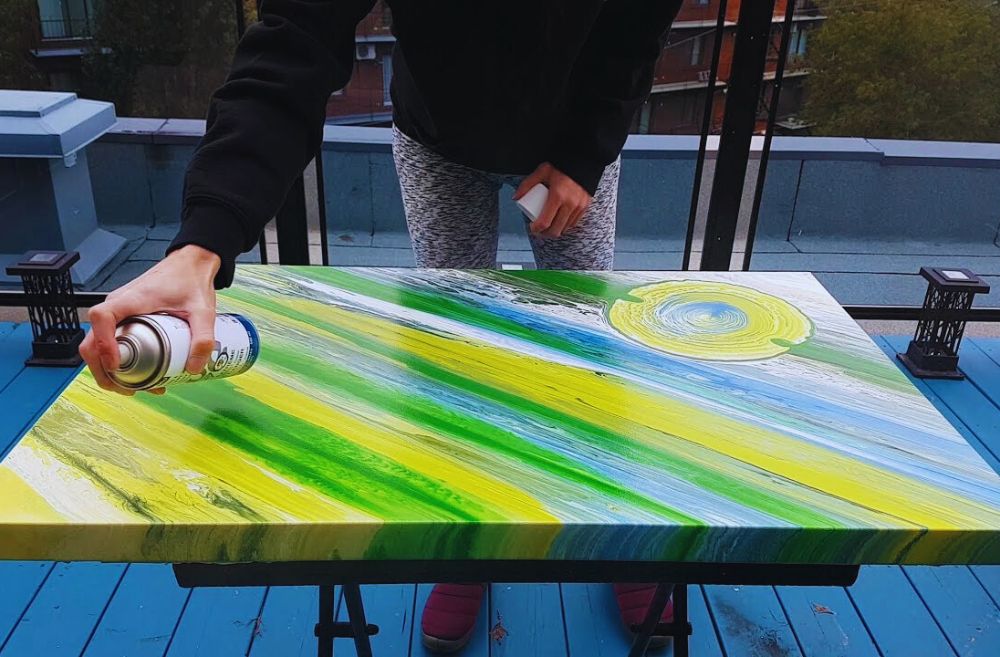In the world of acrylic painting, achieving a glossy, professional finish is often the goal of many artists. One essential tool in accomplishing this is gloss varnish. Gloss varnish for acrylic painting is a transparent liquid applied over completed acrylic paintings to enhance their appearance and protect them from various environmental factors.
Table of Contents
Types of Gloss Varnish

There are primarily two types of gloss varnish: water-based and solvent-based. Water-based varnishes are favored for their low toxicity and easy cleanup with water. On the other hand, solvent-based varnishes provide a more durable finish but require proper ventilation during application due to their fumes. Additionally, artists can choose between spray-on and brush-on varnishes, each offering its own set of advantages and techniques.
Benefits of Using Gloss Varnish
The application of gloss varnish offers several benefits to acrylic paintings. Firstly, it enhances the colors’ intensity and vibrancy, making the artwork appear more vivid and dynamic. Furthermore, gloss varnish acts as a protective barrier, guarding the painting against dust, dirt, and harmful UV rays. Finally, gloss varnish creates a glossy finish that gives the artwork a professional and polished look.
How to Apply Gloss Varnish for Acrylic Paintings
Proper application of gloss varnish is crucial to achieving the desired results. Before applying varnish, ensure that the acrylic painting is completely dry to prevent smudging or cloudiness. Depending on personal preference and the size of the artwork, artists can choose between brushing or spraying the varnish. When brushing, use long, even strokes to avoid streaks or bubbles, while spraying requires a steady hand and controlled application.
Factors to Consider When Choosing Gloss Varnish

When selecting a gloss varnish for acrylic paintings, artists should consider several factors. Firstly, ensure that the varnish is compatible with acrylic paints to prevent any adverse reactions. Secondly, determine the desired level of glossiness, as varnishes are available in varying degrees of shine. Finally, consider the longevity and durability of the varnish to ensure the artwork remains protected and vibrant for years to come.
Common Mistakes to Avoid
While applying gloss varnish may seem straightforward, there are some common mistakes that artists should avoid. One such mistake is applying varnish too soon, which can result in smudging or lifting of the paint layers. Additionally, overworking the varnish can lead to uneven application and streaks. Finally, using low-quality brushes or applicators can leave behind unwanted marks or hairs in the varnish.
Maintaining and Removing Gloss Varnish

After applying gloss varnish, it’s essential to properly maintain brushes and tools to ensure longevity and optimal performance. Clean brushes and applicators immediately after use with soap and water for water-based varnishes or appropriate solvents for solvent-based varnishes. If corrections or restoration are needed, varnish can be removed using specialized varnish removers or solvents, allowing artists to refine their artwork as needed.
- Gloss varnish for acrylic painting adds a protective layer that shields the artwork from dust, dirt, and UV damage.
- Applying gloss varnish enhances the colors in acrylic paintings, making them appear more vibrant and saturated.
- Gloss varnish creates a glossy finish that adds depth and richness to the artwork, giving it a professional look.
- Varnishing acrylic paintings with gloss varnish can help unify the surface sheen, especially if different areas have dried with varying levels of gloss.
- Gloss varnish is easy to apply and dries clear, preserving the original appearance of the acrylic painting.
- Using gloss varnish can intensify the contrast between light and dark areas in the painting, enhancing the overall visual impact.
- Gloss varnish can be used to create a wet-look effect, making colors appear more saturated and luminous.
- Varnishing with gloss varnish can make acrylic paintings easier to clean and maintain over time.
- Gloss varnish is compatible with most acrylic paints and can be used on a variety of surfaces, including canvas, wood, and paper.
- Applying gloss varnish to acrylic paintings is a simple yet effective way to protect and enhance the artwork, giving it a professional finish that lasts for years.
FAQS
- What is the difference between gloss, satin, and matte varnish?
- Gloss varnish provides a shiny finish, satin varnish offers a subtle sheen, and matte varnish creates a non-reflective surface.
- Can gloss varnish be used on oil paintings?
- Yes, gloss varnish can be used on oil paintings to protect and enhance the colors, but ensure the painting is fully dried before application.
- How long does gloss varnish take to dry?
- The drying time of gloss varnish varies depending on factors such as temperature, humidity, and application thickness, but typically ranges from a few hours to overnight.
- Is gloss varnish waterproof?
- Yes, gloss varnish forms a protective barrier that is resistant to water and moisture, helping to preserve the artwork.
- Can gloss varnish be applied over a matte painting?
- Yes, gloss varnish can be applied over a matte painting to alter the finish and provide added protection, but ensure the painting is fully dry before application.
Conclusion
Gloss varnish plays a crucial role in enhancing and protecting acrylic paintings. By understanding its benefits, application techniques, and maintenance tips, artists can achieve stunning results that showcase their creativity and craftsmanship. Experimenting with gloss varnish allows artists to explore new possibilities and elevate their artwork to new heights.
